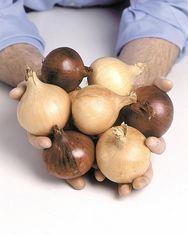
Bill Rix, chairman of the British Onion Producers’ Association said: “We experienced the wettest August in 100 years with, typically, 145mm of rain, compared with 8.8mm last August.”
The conditions were, in fact, in direct contrast with the previous August, which saw record dry conditions and low yields.
Rix added: “The result of the wet weather has meant a general down grading of quality with skinning, staining and neck rot being the main offenders.” The rain also caused a late growth spurt, resulting in many crops being 25 per cent oversize for packing or processing.
“Because of all this, a large acreage was not harvested and ploughed back in, preventing the market from receiving poor quality samples.”
Chris Wilkinson, director at onion suppliers Interveg, said the wet condition also made disease control difficult: “Many crops could not be sprayed to protect against leaf diseases at the correct time and had to be killed off in the field.”
Despite better growing conditions earlier in the season, there were still problems, said Wilkinson: “While the over-wintered onions were harvested in reasonable conditions in July, they met a totally oversupplied market of late season cold stored onions from the UK and the Netherlands.”
The UK vegetables also came into conflict with late arrivals from New Zealand at low prices. Rix added: “Open price shipments from New Zealand had been sent on the back of high domestic volume and low prices, coupled with the anticipation of high UK values, following on from the low yielding drought harvest of 2003.”
Overall production figures are looking up, with BOPA predicting brown onions to reach 440,000 tonnes, compared to 355,000t in 2003 and 407,000t in 2002, while red onions continue to grow at 50,000t this year, compared with 41,000t last year and 35,000t in 2002.
Rix said that despite the fact there appears to be an abundance of onions this year, there is still opportunity for UK producers: “History tells us that an oversupply is never as big as it seems, and often shortages occur at the end of a potentially oversupplied season.
The high volume, low price market facing UK growers does have advantages however, said Rix, with it making the market less attractive to importers.
“The volume of imported onions stands at a five year low, and while at present prices are depressed, it gives all in the industry the opportunity to regain volumes lost to overseas markets and a platform to build on for the future.”
However, Wilkinson is less optimistic on the supply front: “Although the total volume of onions grown in the UK was significantly higher than last year, the total marketable yield is not, and certainly good quality product suitable for supermarket supply is only just adequate.”
This means, he claimed, that poor quality onions are meeting very low prices and poor demand, while the smaller amount of good quality crops are meeting good demand and reasonable prices. He said the trend is likely to continue until the end of February when ambient stored crops will be cleared.
With regard to market trends, Wilkinson said supermarket sales continue to steadily increase, but a key sector is now in processing.
“The ready meals market continues to expand and is becoming the most important sector in tonnage terms, although intense competition from imported ready peeled onions continues to keep this market under increased commercial pressure.”
Sales to the catering sector were also continuing to grow strongly, with increased orders from the pub and restaurant sector as well as airlines.
“Red onions are also continuing to grow in importance, due to lower retail pricing and promotional activity as well as increased use in salad bars. However supply and demand are in very fine balance now.”
In fact, BOPA’s Rix said there needs to be a significant increase in the production of red onions to meet the year-on-year growth in consumer demand.
Martin McQuaide, operations director with AB Produce, said there is also increased demand for button onions and shallots in the autumn and winter months: “This demand is due to seasonal menu changes, ie more stews and casseroles, and it is also the traditional time for pickling.”
When it comes to format, Wilkinson predicts an increasing swing toward pre-packed produce, away from loose. “While ratios vary significantly between retailers, the most successful generally have a higher proportion of pre-pack sales to loose,” he added.






No comments yet